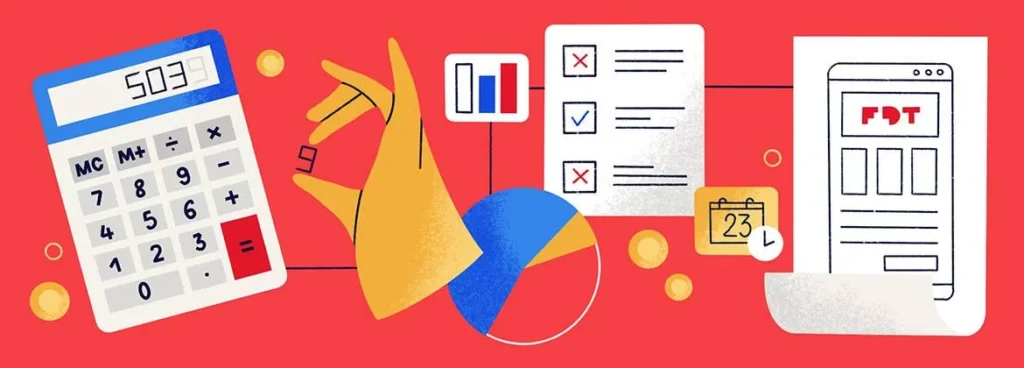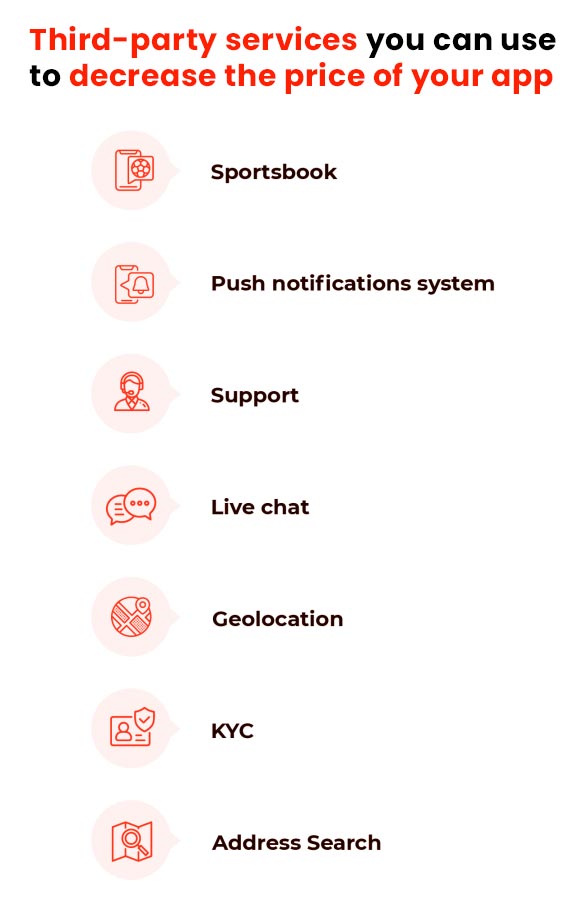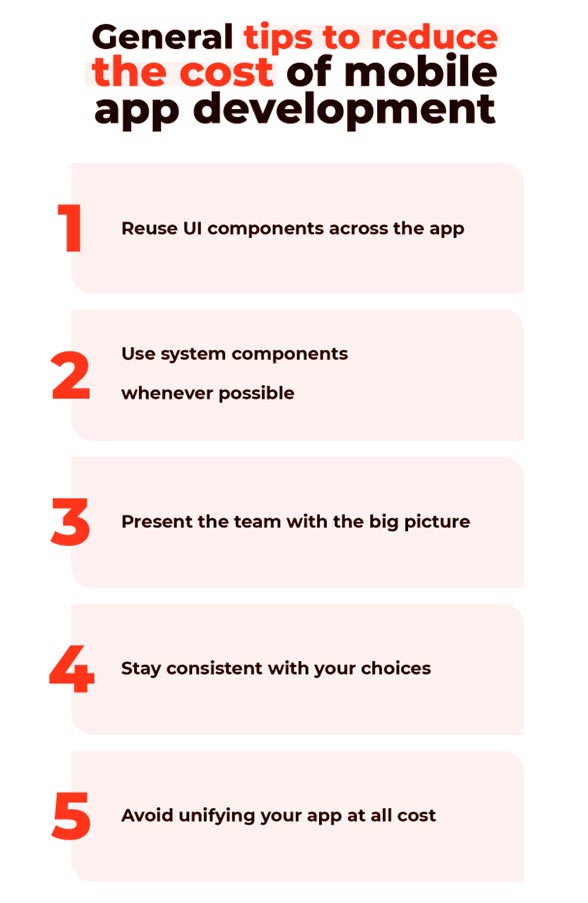Mobile application development is not child’s play. In fact, many aspects must be brought together to create a functional app that meets users’ demands. In our previous article, we provided you with a comprehensive guide on how to prepare for sports betting mobile app development to avoid failures along the way and ensure its ultimate success. Although the text relates to gambling apps, included tips and tricks apply to other types of applications as well.
Now, let’s assume you followed our advice and consulted the vision of the product with your internal team or the company you outsource the project to. After preparing a preliminary cost estimate, you are certain the budget will not tie up. So you have two options – either extend your financial resources or apply solutions that will reduce the price of the project.
As we are perfectly aware of the struggle between delivering high ROI and maintaining the quality of the product, we came up with a list of solutions that may help you decrease mobile app development costs and conquer the market with an affordable yet successful mobile application.

How to cut the cost of app development with MVP?
Let’s start with MVP. Minimum Viable Product is quite commonly used in the software industry for two reasons. First, developing a stripped-down version of a product allows developers to assess its functionality and verify which aspects should be improved to meet users’ demands. Second, it helps clients validate their business ideas before sinking funds into an unprofitable project. So it’s like a dry run for your app.
MVP incorporates features that enable a product to be introduced to the market and put through preliminary testing or user evaluation. In other words, it is an app that is fully operable but includes only primary functionalities, which means that the number of technologies and amount of time required to create such a prototype is drastically reduced. Hence, creating an MVP of your product is a strategy that allows you to deliver a quality product without spending a fortune on development.
However, while preparing an outline of the MVP, be careful what you decide to cut off from the scope. At the end of the day, you don’t want to end up with a product that cannot function properly and is deemed impractical. Here’s a list of things that can be safely skipped in most MVP versions.
Animations
Although animations can improve the user-friendliness of your app, they are typically difficult to implement. If you cannot imagine your application without animations, consider Lottie. It is a cross-platform library for iOS, Android, and Web applications that generates vector-based animations and graphics in real time with little code. To prepare such animations, use After Effects, Sketch, or Haiku.
Push notifications system
We admit that push notifications are vital for communicating time-sensitive messages to your customers. Yet, coding an advanced push notifications system is often complicated and time-consuming. So unless you develop a health care app that is supposed to remind the user about medications or any other application in which such messages are required, you may not include them at an early stage.
Complicated UI
A well-designed UI is undoubtedly an integral part of an application since it impacts customer engagement and satisfaction. A visually-appealing yet intuitive and responsive design may boost customers’ willingness to use the app regularly and recommend it to others, increasing your profits. Yet, an MVP version of your app does not have to be a masterpiece. It should be functional and attractive, but any advanced UI solutions can be introduced at subsequent stages of the project.
An example of an initially optional feature is a betting reward system. This element is frequently used in betting applications to increase users’ engagement and consequently boost customer retention. But since the design of reward systems requires a lot of time and effort, it may be wiser to introduce it in the final version of the application.
Advanced support
Support is more than welcome in most applications, as it improves an app’s quality and builds trust for a brand. Thanks to this element, issues can be reported and resolved directly, boosting customer satisfaction and retention. In MVP, however, advanced means of support, such as an automated ticketing system or live chat, can be substituted by less complex solutions, like a contact form. Although the idea is far from perfect, it allows you to butter both sides of the bread – maintain sufficient customer support with much lower development costs.
The above suggestions are only examples of features you can cut from the scope in the early phase of the project development, as they may differ depending on the industry. Determining which functionalities are essential and which are not is not always clear-cut, so don’t be concerned that you still wonder how to approach this issue.
To make a reasoned decision, identify the main objectives of your product and assess your financial abilities. Once you determine these factors, discuss them with your software development partner. Thanks to prior experience in a particular industry, the company will be able to define crucial aspects of the project and tell you which elements should be included in your app’s MVP.
If you want to learn more about reducing the costs of MVP, we have already covered the issue in one of our articles, so have a look.
Reduce mobile app development costs by collaborating with third-party providers
Coding every element of software from scratch is not the only way to develop an app, as some components of your application can be supplied by third-party providers. Such ready-made services may reduce the cost and time required for the development so if you have a limited budget, consider supplementing your project with some of the solutions specified below. In case you are unsure how to select the right provider, read the preceding article in this series. Now, it’s time to examine what savings you can make by using external services.

Using a third-party sportsbook in your betting project is a simple way to save time and money on development. If you decide to do so, you have two options – supply only the data and create the design yourself or use an off-the-shelf sportsbook along with UI components. The former approach is more time-consuming but allows for an app’s customization, which makes it stand out from the competition. The latter, on the other hand, accelerates development while allowing only minor UI modifications.
Regardless of the variant you select, make sure that the sportsbook’s supplier provides you with appropriate documentation, configurable SDKs, and support in case of any integration issues.
Push notifications system
Another feature to consider while defining the development scope is a push notification system. Push notifications aim to engage regular users and reactivate those who downloaded an app but stopped using it. These pop-up messages provide significant value to the product as they allow you to alert customers about special deals or upcoming events, bringing traffic back to your application and increasing sales. However, since building an effective notification system takes a significant amount of time, effort, and financial resources, third-party suppliers may come in handy. By using their ready-made tools, you can speed up the development process and cut back on costs.
There are many push notification systems providers on the market, starting from mainstream OneSignal and Google Firebase to a bit less popular but still functional PushBots. Some of them offer way more than push notifications, for example, internal messaging, notifications storage, A/B testing, and marketing analysis. With the variety of functional push notification systems on the table, there is no need to exceed your budget and timeline of the project to develop one from the ground up
.Support
No matter how hard you want your app to be perfect, there will always be some issues to resolve. App support prevents the escalation of such problems by fixing reported bugs, providing users with account assistance, and answering customers’ queries as soon as they appear. A well-configured support system is critical for building trust and ensuring a positive User Experience.
Thus, to avoid poor ratings in leading marketplaces, like the App Store and Google Play, and a decline in the number of downloads, you should definitely include some kind of support in your app. Its form depends on the size of the project, the type of application you create, and the amount of money allocated for its development. Complex applications with high traffic are more prone to repetitive bugs and generate a lot of requests, so they require extensive technical support. If you struggle with a similar situation but you lack the appropriate human or financial resources to manage it internally, you should consider using reliable and more economical external services.
In the case of apps generating little traffic, customers’ inquiries are less frequent, so a comprehensive support system can be replaced with unsophisticated feedback collection mechanisms. A well-described FAQ, a contact form, or a brief survey included in a push notification are only a few examples of how to approach the issue. All of these features are way easier to integrate and manage, decreasing the overall costs of development.
Live chat
Providing users with a live chat is recommended for applications operating in various industries. Thanks to this functionality, you can easily address your customers’ complaints and queries, shortening the conversion path and improving their overall experience with your customer service. What’s more, you get an opportunity to learn users’ viewpoints and enhance your product based on the feedback.
But despite all the benefits, the development of a chat feature can consume a lot of your resources. So if your app needs advanced support to deal with a large number of simultaneous requests but your time and budget are somewhat constrained, you should consider integrating an off-the-shelf live chat. Such a solution is stable but its integration is far cheaper, so it will enable you to trim the expenses or shift funds to deploy more urgent features.
Geolocation
If your certification authority requires advanced geolocation, it is probably better to put your trust in some provider instead of doing it all by yourself. The list of API geolocation software you can rely on comprises IP2Location, GeoSurf, MaxMind, and many more. With a third-party geolocation service, you can maintain security and compliance, customize content and advertisements, and manage digital rights cost-effectively.
Address search
An autocomplete widget is employed in applications that collect addresses for delivery or other location-related purposes. It is used to speed up and simplify filling out the order forms by providing on-the-fly suggestions concerning the address, postcode, city, or place name as the user is typing. Given there are plenty of verified address autocomplete APIs on the market, developing it from scratch would only extend the timeline of the project and generate unnecessary costs.
KYC
Know Your Customer (KYC) is a standard procedure in the financial sector applied to verify a client’s identity. Similar to geolocation, KYC provisions may differ depending on the region. If you develop a FinTech app and your certification department demands an advanced KYC process, a suitable API can help you meet the requirements and avoid fines. In addition, it can protect your business from fraud by identifying suspicious users and separating them from legit ones. Hence, investing in cooperation with an experienced KYC provider may pay off, as you will be able to launch your app anywhere and stay in compliance with all regulations without additional time and effort.
There are plenty of other features third-party providers can supply you with to decrease the cost of developing your mobile app. The above are examples of ready-to-use solutions that were frequently employed in applications operating in various industries, so we assume they may suit your project’s needs as well.
But finding ways to reduce the overall cost of your mobile app doesn’t end here. Let’s check whether developing an application in cross-platform technology can bring down its price.
Can a cross-platform solution save you money?
Loads of companies, especially startups, choose cross-platform technology for their application development because it enables them to quickly and affordably reach a great number of users through multiple channels. In the native vs cross-platform app development battle, the latter outperformed the former in such aspects as the cost and time required to build the product. Is it, however, a miraculous solution that can reduce the price of your app without losing quality? To answer this question, we should investigate the issue from different perspectives.
Required performance
For the majority of applications, the level of performance available in cross-platform technology will be sufficient. However, betting or financial apps require fast processing of massive volumes of data coming from different sources and are hence way more demanding in this matter. Real-time delivery of crucial information regarding wagers or currency rates is vital in keeping an app functional and useful. Applications characterized by these qualities are prone to meet users’ needs and gain favorable reviews in marketplaces.
Unfortunately, cross-platform applications may be inefficient in this regard, as they usually operate in a single-thread model and require additional rendering. In the performance analysis of native and cross-platform mobile applicFations, the native iOS app proved to be 60% faster than the hybrid app.
If you create a complicated and performance-demanding application, such as a sportsbook, a cross-platform solution might be too cumbersome, discouraging customers from using it. So even though the development process is cheaper, the solution is not profitable in the long run. It should be emphasized, however, that cross-platform frameworks, such as Flutter, are constantly evolving, and their deficiencies with respect to native technologies might be eliminated any time soon.
Use of third-party components
If you decide to use third-party components in your product, you should be aware that integrating them into a cross-platform application might be a bit problematic. It is due to a lack of sufficient documentation concerning the implementation of selected features into cross-platform software. Thus, although you have ready-to-use elements, your development team might encounter troubles connecting them to your cross-platform app, which may significantly increase their workload and extend the timeline of the project. Needless to say, any delays in the app’s release impact your business revenue.
UI/UX design
Thanks to a single source code, changes in a cross-platform app’s UI are automatically updated on multiple platforms, so its visual layer remains consistent across disparate devices without additional development effort. In applications based on native technology, any modifications to the interface demand extra work, thus using a cross-platform framework works in your favor in this regard.
All in all, can cross-platform technology reduce the mobile app development price? Well, as always, it depends. Since every project has different aims and demands, there’s no one correct answer to this question. To be on the safe side, better discuss the issue with your app development company and decide whether this solution suits your needs.
General tips to reduce the cost of mobile app development
Besides the above tips and tricks on how to decrease development costs throughout the process with MVP, third-party providers, or cross-platform technology, we also have some other hacks that may prove to be equally useful in this regard. We hope that these pieces of advice will help you develop a mobile app in the most efficient way.

Use system components whenever possible
It is beneficial in two ways. First, users are used to specific solutions for their platforms, so it’s safe to use systems that everyone enjoys instead of rethinking them. Second, you don’t have to spend time designing the new components and testing them afterward. Another advantage of this solution is there is very little chance that something will go wrong with these components, as they have already been implemented and checked in other software. Thus with this one small rule, you save time on design, development, and even testing.
Present the team with the big picture
Although it seems obvious, this step is frequently overlooked, which affects the flow of work. Presenting the development team with a detailed vision of a product is the foundation of every project. That’s why it is essential to define the basic assumptions, main objectives, and primary functionalities of your application and communicate them as soon as possible. Ideally, the Project Manager should be a mediator between you and the team. With such an overview, the team can plan subsequent stages of the project and complete individual tasks more effectively.
Stay consistent with your choices
Changing your mind can be very expensive. For this reason, carefully consider your expectations and make sure that the accepted product design reflects your vision as accurately as possible. To do it accurately, put emphasis on business analysis, product discovery, and product design workshops during which you can discuss potential problems and risks that the project might encounter with the product development team. Such an approach might spare you additional expenses resulting from mistakes and modifications that could be easily avoided.
Avoid unifying your app at all costs
If you decide to create two native versions of your app, you can expect certain differences between them. This is due to the fact that various platforms have slightly different UX/UI. Unifying your software across operating systems, such as Android and iOS, requires additional work with designing custom components. We are here to tell you don’t have to do this at all costs, as users are accustomed to particular platforms and expect applications to work in a specific manner.
Develop your mobile app on a budget
As you can see, there are plenty of ways to reduce a mobile application’s price. The good news is – you don’t have to sacrifice the quality of your app to stay within budget. In this article, we tried to provide you with solutions that hopefully will allow you to create a functional and viable product without spending a fortune. All this knowledge comes from first-hand experience, so have no fear of using it in your project.
Yet, if you still have some queries regarding best practices for cutting development costs, don’t hesitate to contact us! Our mobile app developers can gladly assist you in determining what is ideal for your project.
